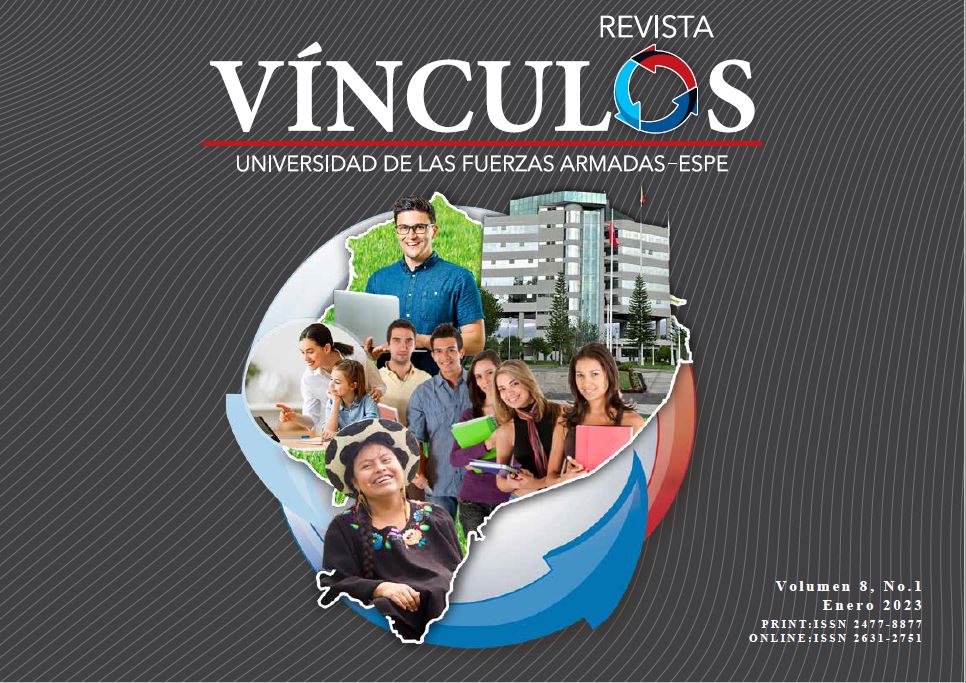OPOL method in Early Childhood Education, for the teaching-learning of vocabulary in the English language
Main Article Content
Abstract
Learning a foreign language can be tedious, in addition to the fact that in Latin America there is not much interest in wanting to learn a new language, but what would happen if good foundations are given from childhood, which is why this research aims to demonstrate that the OPOL method allows infants to create the basis for increasing or improving language (vocabulary) in the English language, thanks to the presence of brain plasticity in their first years of life, which at the same time does not generate a space of stress in the teaching- learning process. Using a quasi-experimental methodology for the research.
We worked with two groups as a sample for the application of the OPOL method, an “uncontrolled” group, using its own methodology “Hihg Scope” and another “controlled” group in which the selected method would be applied, for this the children had two moments of evaluation (pre-test and posttest), through an interview as a game, in order to analyze the results before and after the application of the research, the averages of 4 categories raised in the checklist per group were analyzed. Showing positive results in the controlled group in the final evaluation.
Downloads
Article Details

This work is licensed under a Creative Commons Attribution-NonCommercial-ShareAlike 4.0 International License.
Los autores que publican en esta revista están de acuerdo con los siguientes términos:
- Los autores conservan los derechos de autor y garantizan a la revista el derecho de ser la primera publicación del trabajo al igual que licenciado bajo una Creative Commons Attribution License que permite a otros compartir el trabajo con un reconocimiento de la autoría del trabajo y la publicación inicial en esta revista.
- Los autores pueden establecer por separado acuerdos adicionales para la distribución no exclusiva de la versión de la obra publicada en la revista (por ejemplo, situarlo en un repositorio institucional o publicarlo en un libro), con un reconocimiento de su publicación inicial en esta revista.
- Se permite y se anima a los autores a difundir sus trabajos electrónicamente (por ejemplo, en repositorios institucionales o en su propio sitio web) antes y durante el proceso de envío, ya que puede dar lugar a intercambios productivos, así como a una citación más temprana y mayor de los trabajos publicados.
How to Cite
References
Callan, D. E., Tajima, K., Callan, A. M., Kubo, R., Masaki, S., & Akahane-Yamada, R. (2003). Learning- induced neural plasticity associated with improved identification performance after training of a difficult second-language phonetic contrast.
NeuroImage, 19(1), 113–124. https://doi.org/10.1016/S1053- 8119(03)00020-X
Chicaiza Flores, V. A. (2019). Universidad Central del Ecuador Universidad Central del Ecuador (Issue Figura 1) [Universidad Central del Ecuador]. http://www.dspace.uce.edu.ec/bitstream/25000/18847/1/T-UCE-0010-FIL-437.pdf
Danjo, C. (2021). Making sense of family language policy: Japanese- English bilingual children’s creative and strategic translingual practices. International Journal of Bilingual Education and Bilingualism, 24(2), 292–304. https://doi.org/10.1080/13670050.2018.1460302
GARCÉS-VIEIRA, MARÍA VIRGINIA-SUÁREZ ESCUDERO, J. C. (2014).
Neuroplasticidad: aspectos bioquímicos y neurofisiológicos. CES MEDICINA, 28.
Li, P., Legault, J., & Litcofsky, K. A. (2014). Neuroplasticity as a function of second language learning: Anatomical changes in the human brain. Cortex, 58(June), 301– 324. https://doi.org/10.1016/j.cortex.2014.05.001
Macro, Z. (2009). El Marco Común Europeo de Referencia (MCER). CEFR. https://www.examenglish.com/CEFR/cefr_es.php
Mora, M. C. F., & Martín-Pulido, S. (2015). Enseñar inglés en educación infantil: Materiales y recursos. Tonos Digital, 29, 49–62.
Moreno Agurto, V. A. (2020). La importancia de la enseñanza del idioma inglés en la etapa escolar. Alétheia, 8(8), 41–52. https://doi.org/10.33539/aletheia.2020.n8.2422
Narcisa, A., Espinales, V., Alberto, J., & Moreno, V. (2021). Neurolinguistic programming in the teaching- learning process of English as a foreign language PJAEE, 18 (4) (2021) 5566 Neuro-linguistic programming in the teaching- learning process of English as a foreign language. Journal of Archaeology of Egypt/Egyptology, 18(4), 5566–5576.
Palomares Cuadros, J. (2020). Catálogo de publicaciones del Ministerio. Mosaico Revista Para La Promoción y Apoyo a La Enseñanza Del Español, 38, 70–87.
Perea, Roxana; Despaigne, O. (2021). Bilingüismo . Importancia y beneficios para los niños. Boletín SIED, 3, 68–76.
Quidel Cumilaf, D., Del Valle Rojas, J., Arévalo López, L., Ñancucheo Chihuaicura, C., & Ortiz Neira, R. (2014). La enseñanza del idioma inglés a temprana edad: su impacto en el aprendizaje de los estudiantes de escuelas públicas. Vivat Academia, 0(129), 34. ttps://doi.org/10.15178/va.2014.129.34-56
Ruiz Martín, A. (2017). Mixed system 1: a language strategy for bilingual families TT - Sistema mixto 1: una estrategia lingüística para familias bilingües. Elia, 1(17), 125–156. https://www.proquest.com/scholarlyjournals/
mixed-system-1-language- strategy-bilingual/docview/2007680334/se- 2?accountid=15198%0Ahttp://www.yidu.edu.cn/educhina/educhina.do?artifact=&svalue=ELIA&stype=2&s=on%0Ahttp://pqdt.calis.edu.cn/SearchResults.aspx?p
Salmerón, A. S., Cristina, A., Infantil, E., & Educación, M. De. (2018). La enseñanza bilingüe desde la Educación Infantil. Publicaciones Didácticas, 200–204.
Sánchez Quesada, B. (2012). Adquisición de vocabulario inglés en segundo ciclo de Educación Infantil a través de la tecnologíay materiales tradicionales. Tes. http://tauja.ujaen.es/bitstream/10953.1/2497/1/SNCHEZ_QUESADA_BEATRIZ_ TFG_EDUCACIN_INFANTIL._PDF..pdf
Santamaría González, S. (2015). Enseñanza del Inglés en Educación Infantil desde una perspectiva lúdica . Universidad de Valladolid.
Serra, M., Serrat, E., Solé, R., Bel, A., & Aparici, M. (2000). La adquisición del lenguaje. 605 p. (pp. 89–94).
Vega Falcon, V. (2021). Neuroeducacion y el aprendizaje de una lengua extranjera en la primera infancia. Boletín SIED, 1(69), 5–24.
Vélez Valero, M. R., Tomasetti Martínez, M. de los Á., Fernández Garrido, M. de los L., & Martínez Sagredo, F. J. (2000). Jugar y aprender : talleres y experiencias en educación infantil. Barcelona : Octaedro, 2000. https://redined.educacion.gob.es/xmlui/handle/11162/58455
Verbrachte, M. (2019). Ecuador queda en el puesto #81 en el ranking de inglés EF EPI GO Blog | EF Blog Ecuador. EF Blog Ecuador/ Go Blog. https://www.ef.com.ec/blog/language/ecuadorqueda-en-el-puesto-81-en-el- ranking-de-ingles-ef-epi/

